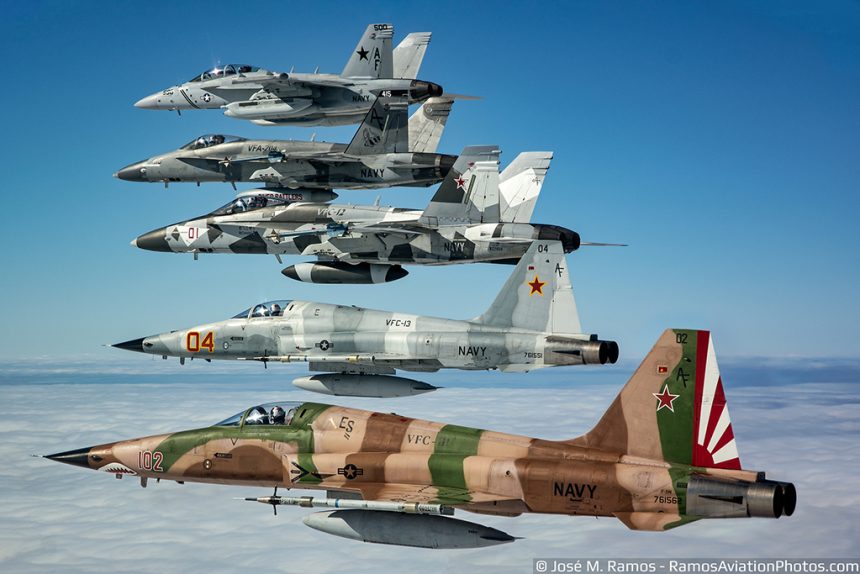Ramos is The Premiere Aerial Photographer of U.S. Navy Aviation, Look at His Stunning Shots.
Aviation fans everywhere are disappointed at the delay of the upcoming “Top Gun: Maverick” release until December 23, 2020. The delay, announced on Thursday, April 2, 2020, is in response to the global COVID-19 pandemic.
While the delay is bad news to all aviation and movie fans, ace aerial photographer José “Fuji” Ramos has some shots that will definitely “bring back that lovin feelin’” and hold us over until Christmas.
José Ramos told TheAviationist in an interview that, “I got into aviation photography like a lot of people did, because of the movie Top Gun. It was the summer before my Junior year in high school and after that I was hooked. The visuals were just to die for, it became an obsession, and still is to this day.”
Ramos developed his expertise and enthusiasm before the age of digital photography and social media. Being an aviation photographer was much harder work then, using film cameras and having very few resources to learn aviation photography and technology beyond print media at the time. Today, his work has been published around the world in publications like Combat Aircraft, Air Forces Monthly, Fly Past and Koku-Fan. You can follow his photography on Instagram at @fujiramos13 and on Facebook at Jose’ M. Ramos Aviation Photography (also linked at the end of this article).
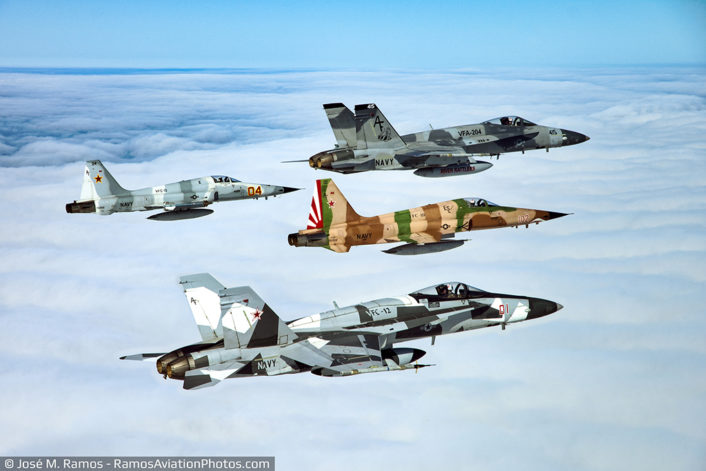
“Because there was no internet to find pictures of military jets, I started collecting all manner of aviation books, in particular the high-end coffee table type and the two biggest influences there were CJ “Heater” Heatley’s The Cutting Edge and Katsuhiko Tokunaga’s Super Blue. After my senior year, I moved from Knoxville, TN, where I was raised, to NAS Key West with my brother. It was there I fell in with VF-45, the local adversary squadron, and my real adventure began. As in anything, you form friendships and build relationships and 9 years later I was presented with the opportunity to get my qualifications for select passenger status and have been doing it ever since. It’s been an honor so far and I’m looking forward to getting back to it once the present global unpleasantness is behind us.”
Photographing high performance combat aircraft from the cockpit is not an easy job. Ramos fights G-forces, airsickness, difficulties in adapting equipment, glare from cockpit canopies, instantly changing lighting conditions due to rapid maneuvering and a nightmare of compositional challenges that make his photography among the most difficult on earth. These photographic challenges are on top of the enormous stress of just flying in a fighter cockpit, an environment that would have most photographers reaching for the barf-bag, not the shutter release.
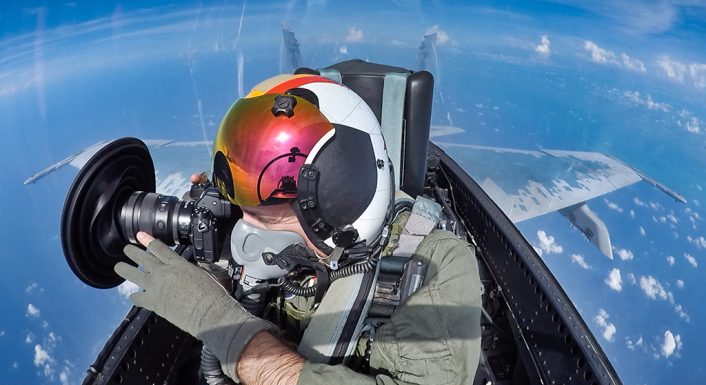
Ramos told TheAviationist:
“There are several challenges in shooting from the cockpit of a tactical jet, all of them physical and quite a few mental. First of all, you’re encased in about 50 pounds of flight gear, then you’re strapped into an ejection seat at 8 points. It’s very restrictive and you have to fight the straps, sometimes the g forces to get the shot. There’s glare to contend with and having to communicate with your pilot to position yourselves and your subject for what you’re envisioning. All the while keeping in mind where you are in three-dimensional space, being aware of what you can and cannot touch in the cockpit and hopefully not getting ill. I have never gotten sick in the jet, but I’ve been uncomfortable enough to have turned a bit green a few times. Being physically fit, not something I’ve always been good at, helps. The more you take care of yourself the better your body handles it which means your mind is more on the task at hand than any potential discomfort you’re feeling. Still, it’s a fine line as I learned in January. I recently have been taking a lot better care of myself but one day last January at Jax I was dehydrated and it made a very dynamic flight much tougher than it should have been which affected how well I did my job when it came down to it. I still got some really great images, but I know I could have done better and that eats at me.”
Ramos has developed unique technical insights into the rarified world of air-to-air photography, and his equipment choices and set-up techniques have been refined over the years by the demanding environment and Mach-speed pace of aerial combat photography. One thing Jose Ramos emphasized was that equipment, especially early on, was not the most important aspect of his photography. He also tells TheAviationist about his most recent evolution in photo technology:
“When I was first starting out, straight out of high school in 1988, I used a collection of manual focus Pentax and Chinon cameras but my eye was always on Nikon. In the early 90s I finally got the Nikon 8008s and have been a Nikon guy ever since, running through quite a few of the film cameras before making the switch to digital in 2006. I’ve made a bit of career using what many think of as “unprofessional” consumer level gear in this environment. As you know, the internet is full of “experts” saying you can’t be a pro if you don’t use this or that. I love showing them my magazine covers shot with D7100 and D7200s. Nikon has also used me at shows and events to stress how versatile those systems are. Recently I did make the jump to full frame and mirrorless by embracing the new Nikon Z system. I personally love it, I love the smaller form-factor and lighter weight (similar to the DX format systems) which to me means greater safety in the cockpit and its easier to manage in the confined space. It packs a huge amount of versatility into a small package. Having done several air-to-airs with the Z system, I’m sold and think it’s the best camera I’ve shot with.”
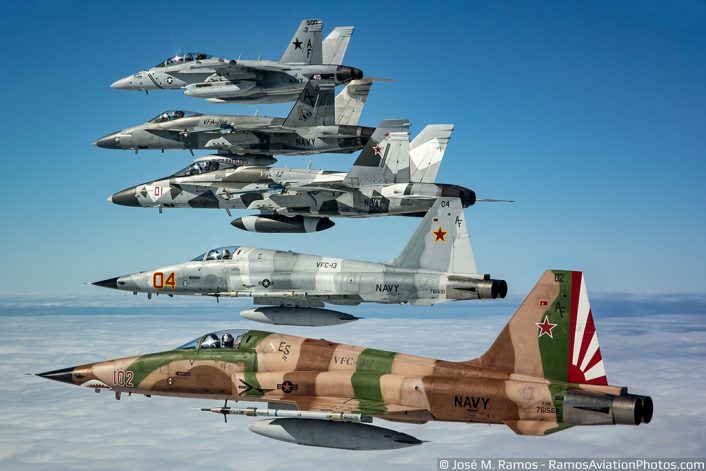
Ramos posted the shot headlined here the same day that Paramount Studios announced the delay of “Top Gun: Maverick”. And while everyone’s anticipation of the film sagged on news of the delay, it was Ramos’ beautiful, inspiring image that caused spirits to soar again on Instagram when they saw his photo of this unique formation of U.S. Navy Aggressors. But the photo did not “just happen”. It took a remarkable amount of planning to make this shot happen. As it turns out, the story behind the photo is as remarkable as the image itself:
“The image, which I titled “Bad Guy Central”, was part of a shoot at the request of Tactical Support Wing. They’d asked me to come down to Key West and document the five squadrons assigned to them, VAQ-209, VFA-204, VFC-12, VFC-13 and VFC-111, in a series of formations. This is pretty rare because it was a dedicated shoot from beginning to end. Most of the time I’m on a “not to interfere” status so that means we still have to support the training programs and shooting images is secondary. I of course wanted to also concentrate on putting the four adversary squadrons in a formation together as they are the backbone of the US Navy’s air-to-air training programs, from basic ACM at the Fleet Replacement Squadron level to full on simulated air wars in larger exercises. Before we even walk out to the jets, we have a detailed brief where the objectives are laid out, all the formations I have in mind are tabled and planned out from the pilots’ perspectives. Some of the formations and ideas I have get modified, some get accepted outright and others are thrown out for a variety of reasons; usually time and complexity in relation to everything else we’re trying to accomplish on the flight. Having been at this for over 20 years, I’m pretty safety conscious and therefor I rarely submit something that get me the “are you crazy?” look from those assembled. Once the brief is complete and everyone is on the same page, it’s time to suit up in the PR shop and walk to the jets. Once airborne I’m shooting almost immediately as it’s usually possible to get shots of opportunity on the way out to our operating area. Once there, we execute the plan according to the brief, usually not deviating too much from it and again making sure everyone knows their part in the changed set up if there is one for safety’s sake because we have so many airplanes in such a small bit of airspace. As the photo-ship, we have a bit more freedom in our movements as I communicate with my pilot constantly via the ICS on where we need be and for him or her to issue instructions to the subject aircraft to fine tune their positioning to get the image I want. It’s really a lot of people, in this case, six people in five aircraft, working together to produce a series of images that will be beneficial to the Navy in terms of public relations and recruiting. And while I know I’m not the central player in this, I know that the success of those overall efforts comes down to me and my Nikons. It’s a big responsibility, a huge honor and I’m very lucky and thankful to be an associate member of this community telling their stories.”
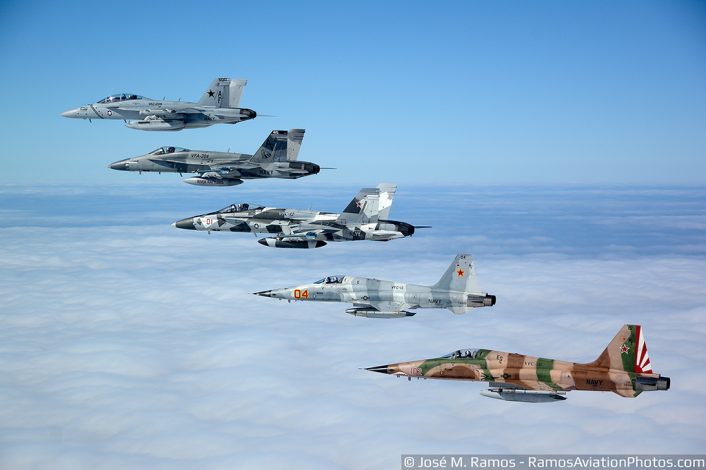
While the delay of “Top Gun: Maverick” still stings, the real-life story of Jose Ramos and his remarkable photographs and career are actually more interesting than Hollywood’s fictional characters. When it comes to Top Gun photographer Jose Ramos, this is a case of truth being much more remarkable than fiction.
Be sure to follow Jose Ramos on Instagram and Facebook- Instagram: @fujiramos13 Facebook: Jose’ M. Ramos Aviation Photography.

